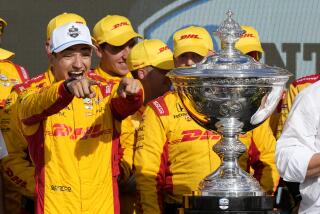INDY: SO MANY FACES, SO FEW STARS : 500 : The Brickyard Still Is His Carnegie Hall
- Share via
INDIANAPOLIS — You imagined God sounded like this. These deep baritone, almost bass, tones ringing from on high. Coming out of the clouds. Operatic, almost. The sound of doom, on occasion. Of salvation, on others. The perfect backdrop for the cacophony of the engines. In command.
Little Al Unser may not be here. No Andretti. No more Foyts and Rahals. Gurney is gone.
But Tom Carnegie is still here. He is Indy’s rock. The Voice of the 500. He carries a microphone--but he doesn’t need it. You can hear Tom when he’s in fine, full voice as far downstate as Evansville. Louisville, for that matter.
He came aboard here when the Brickyard was almost just that. A weed-grown empty lot from which the roar of the roadsters had long since departed. In danger of becoming an heirloom, the monument was rescued by the baking powder executive, Tony Hulman, and restored when Hulman decided that, without auto racing, Indy was just another Midwestern railroad stop.
He put Carnegie on the finish line with orders to find a way to dramatize the restoration of the race while he built the stands and opened the souvenir spots and got ready again for “the greatest spectacle in racing.”
That the Indianapolis 500 soon became. It belonged in the fabric of American sport the way the World Series, Kentucky Derby and Rose Bowl did. He built it, and they came.
Carnegie was ready for them. He became as residual a part of the new Indy as the brick on the finish line. For generations of race fans, he was their link, their stake in the Indianapolis 500.
Every sport needs its on-site announcer. The Yankees have the dulcet Shakespearean tones of Bob Shepherd, who can make baseball sound like Hamlet. The Bard of Baseball.
In Indianapolis, it’s Tom Carnegie. He’s as essential to the show as the computers timing the race.
You see, at Indy, you cannot see the whole field. You can only see your own corner.
When trouble looms and drama ensues, you know it only by a yellow gleam on the track bulbs.
Trouble comes in yellow at Indy. A yellow light coming on the track poles can mean anything from a runaway tire to a four-car crash. It can mean anything from a nosebleed to a death.
Carnegie has seen lots of each in his 51 years at the PA system. He can recall the start of the 1964 race, when Eddie Sachs disappeared in a pall of smoke on Turn 4 after crashing into the rookie Dave MacDonald. Both drivers died.
He was there in the terrible year, 1973, when Art Pollard got upside-down in practice and died of his wounds, Swede Savage was to be killed in a fiery crash into the cement on Turn 4--and a crew member, Armando Turan, was killed by a fire engine speeding the wrong way up the pit to reach the accident scene. And the pace car driver crashed into a photographers’ stand.
When the race got too fast to be tracked by the human eye, and even the finish line scoring pylon was 10 laps behind, it was Carnegie who had to keep the crowd abreast.
More than speed has changed in the race. You can get more in lap money now than you used to earn winning the race.
“You remember things in flashes,” Carnegie says.
He remembers the big changes when Britain’s Colin Chapman brought the rear-engined Lotus to the track and revolutionized the game, dooming the dinosaur roadsters.
He recalls 1963, when Parnelli Jones won it, throwing oil onto the path of Jimmy Clark’s pursuing Lotus, with the stewards on the point of black-flagging Parnelli when car owner J.C. Agajanian charged to the steward stand to talk them out of it.
It was Carnegie who would utter the frequent lugubrious “Andretti’s slowing down!” which became a Speedway echo as bad luck bedecked Mario in the late stages of half a dozen races he led.
“I saw many great races,” Carnegie recalls. “Probably the one I remember most is the year [1982] Gordie Johncock and Rick Mears went around the track wheel-to-wheel and in the last 10 laps, Mears was making up one second a lap but Johncock won by an eyelash (0.16 seconds).
“Or the year Parnelli had the turbine car [1967] and led the whole race till it disappeared and stopped on the backstretch with three laps to go and here comes A.J. Foyt to take the checkered flag--only four cars have tangled in the stretch and Foyt barely makes it weaving through like a broken-field runner. I think he finished sideways.”
The Offenhausers are gone. The race is 50 mph faster. The track is run by Hulman’s grandson. But there’s one constant. When you hear the mellifluous voice of Tom Carnegie coming over the loudspeaker, you’ll know you’ve come to the only place in this world where you can hear it. For three generations, he was the real “Mr. 500.”
More to Read
Go beyond the scoreboard
Get the latest on L.A.'s teams in the daily Sports Report newsletter.
You may occasionally receive promotional content from the Los Angeles Times.










